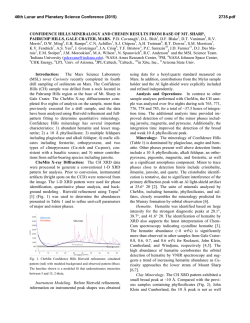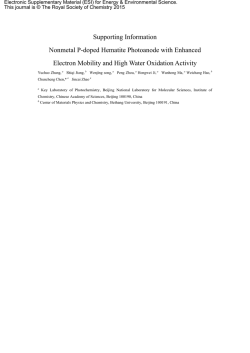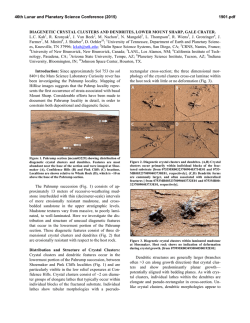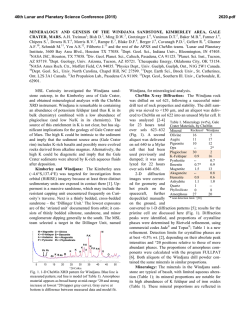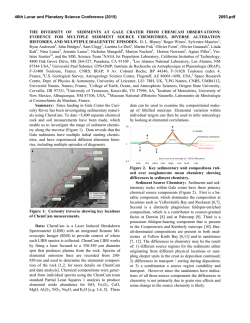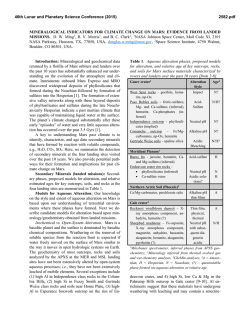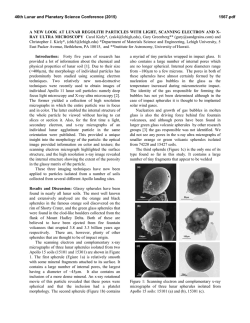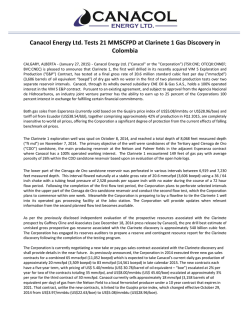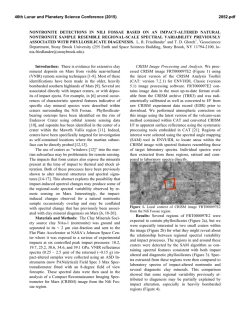
(upper jurassic) of kutch, india
46th Lunar and Planetary Science Conference (2015) 1366.pdf HEMATITE CONCRETIONS FROM JHURAN FORMATAION (UPPER JURASSIC) OF KUTCH, INDIA: POSSIBLE TERRESTRIAL ANALOGUE TO MARTIAN “BLUBERRIES”? 1A. D. Shukla, 1D. Ray, 2S. Bhattacharya and 2P. chauhan, 1Physical Research Laboratory, Navrangpura, Ahmedabad-38009, India ([email protected] and [email protected]); 2Space Applications Centre, Indian Space Research Organisation, Jodhpur Tekra, Ahmedabad-380015, India ([email protected]). Introduction: One of the exciting discovery made by Mars Exploration Rover Opportunity at Meridiani Planum of Mars was the detection of hematite spherules [1,2]. These millimeter-sized spherules so called known as “blueberries”’ and mostly similar in appearance to hematite-rich sedimentary concretions as found on Earth. The formation history of these concretions are mostly diagenetic resulted due to fluid-sediment interactions [3,4,5] and therefore is believed that Martian blueberries also share similar formation history like terrestrial concretions. Earlier, hematite concretions from sandstone or from basaltic tephra were reported as possible terrestrial analogue [6,7]. Most recent study, however, suggest blueberries may not concretions, instead, they are linked to meteoritic origin [8]. Therefore, the formation processes of Martian blueberries is not conclusive yet. Here, we report the spheroidal hematite corrections as found from a sandstone lithounit of Jhuran Formation from Kutch, India. The morphological, mineralogical and reflectance spectroscopic studies are carried out in order to understand the formation condition and therefore our studies could be useful to infer the diagenetic history of hematite concretions on Mars. Geological setting, morphology and mineralogy of concretions: The samples collecetd from the Laiari river section, a small river draining from main land of Kutch towards the Banni Plains. These spherules are found in the upper Jurrasic age sandstones from the Jhuran Formation [9]. In the upper part of Jhuran Formation which is massive current bedded arenaceous have intercalations of shale, siltstone and calcareous sandstone bands, we found the spheroidal Fe concertions (Fig. 1). The concretions are spheroidal or often hemispheroidal in shape, often attached with the lithified sediment. Internal morphology reveals a layered structure with a hematite-rich core (~1.5 cm thick), intermediate sandy layer and hematite-rich surface rind (Fig. 1). The peripheral hematite crust is generally few mm thick. A few concretions are also found only as sanstone-filled cement (Fig. 1). Field observations show concretionsbearing horizon sandstone are red colored and often cross bedded as well. The top most bed are mostly sandy and highly eroded in nature. Backscattered electron (BSE) image shows inclusion of pure Quartz (SiO2 ~ 99 wt%) and K-feldspar (K2O up to 14 wt%) A few K-feldspar often shows alteration (comparatively Al2O3-rich~ 30 wt%). FeOtotal of hematite vary up to 80 wt%. X-ray mapping clearly distinguishes that quartz and K-feldspar occur as detrital grains within the hematite-rich surface rind (Fig. 2). Furthermore, SiO2 also dominates over the Kfeldspar volumetrically and therefore hosts are quartz arenite. Fe Kα Al Kα Si Kα K Kα Fig. 2 X-ray mapping of hematite-rich surface rind Fig. 1 Occurrence of hematite concretion within sandstone of Mesozoic Kuthch, India. b. Cut surface of concretion. Diameter of coin 2.2 cm. Spectroscopic observations: A Visible/Near Infrared (VNIR) FieldSpec® 4 Hi-Res spectroradiometer (Analytical Spectral Devices (ASD), Boulder, CO, USA) having spectral resolutions of 3 nm for VNIR and 8 nm for SWIR-1 and SWIR-2, respectively, has been used to characterize hematite concretions 46th Lunar and Planetary Science Conference (2015) in the spectral range of 400-2500 nm. Data were acquired by using 1 degree FOV supplied with the ASD instrument with 45° incidence angle and 0° emission angle. 70W, 15V illuminator with a fan cooled 12V Quartz-Tungsten-Halogen lamp was used for indoor diffuse reflectance measurements having 12° beam angle and 3100K color temperature. Fig. 3 Reflectance spectra of hematite concretions with characteristic hematite and kaolinite absorption features (Sample Nos. are given as DC-Spectra-XX, where DC stands for Diagenetic Concretions and XX represents spectra no.) VNIR spectra of diagenetic concretions are characterized by a mixture of Fe-oxides and kaolin group minerals manifested primarily by absorption feature near 550 nm followed by a relatively broader and stronger feature, the center of which varies from ~910-925 nm that are consistent with hematite. These two features could be attributed to the Fe3+ charge transition in Fe2O3 [10]. Apart from the broad and strong features associated with electronic charge transition of iron, there are sharper and narrower features observed near 1400 and 2200 nm respectively, primarily resulting from Al2OH overtones and combination bands. The specific band minima positions of the doublets near 1400 and 2200 nm as seen in the spectra of the diagenetic nodules, are suggestive of kaolinite with poorer crystallinity [11]. The concretions also show a prominent asymmetric absorption feature near 1900 nm arising due to the H-O-H combination bend and stretch of structural H2O (e.g., [10,11]). The 1900-nm absorption 1366.pdf also indicates that there may be halloysite present in these samples as it contains structural water [10]. Discussions: Interestingly, earlier Chan et al. (2004) (ref [5]) reported the similar type Fe– concretions as probable Martian analongue, from the lower Jurassic Navajo Sandstone of southern Utah. Our present observation on spheroidal concretions from Jhuran formation share similar color variations and diagenetic iron oxide concretion mineralization, therefore, support formation mechanism might have been same for both. In brief the iron came from dispersed early diagenetic reddening, and the iron mobilization via bleaching through chemical reduction and latter iron oxide precipitation into concentrated concretion masses upon oxidation where reduced fluids carrying iron came into contact with well oxygenated waters [12]. Our field observations further suggest hematite concretions as found within Jhuran sandstone are in situ and diagenetic. The sandstone within concretions and the host sediments share similar composition. Red coloration of the sandstone refer to iron oxides in acidic lake depositional setting under oxidizing conditions. Lack of accretionary growth rings argue against rhytmic climatic varation during the formation of concretion. The contact of Jhuran Formation with overlying the Bhuj Formation is basically the contact between marine and non-marine rocks therefore reflecting the marine regression peroid. This also facilitate the depositional environment shifted from sub-littoral to supralittoral setting and finally into continental deposition of the overlying Bhuj Formation [9]. The changes of depositional setting from sub-littoral to supra littoral in upper Mesozoic of Kutch suggest sedmints were saturated with acidic and saline groundwater which facilitate iron leaching, transport and precipitation. This condition appears similar to Meridiani Planum of Mars and therefore imply aqueous processes of early Mars. References: [1] Christensen P.R. et al. (2004) Science 306, 1733-1739. [2] Squyres S.W. et al. (2004) Science 306, 1709-1714. [3] McLennan S.M. et al. (2005) Earth Planet. Sci. Lett. 240, 95-121. [4] Calvin W.M. et al. (2008) J. Geophys. Res. 113, E12S37. [5] Sefton-Nash E. Catling D.C. (2008) Earth Planet. Sci. Lett. 269, 366-376. [6] Chan M. et al. (2004) Nature 429, 731-734. [7] Morris R.V. (2005) Earth Planet. Sci. Lett. 240, 168-178 [8] Misra A. et al. (2014) Planet. Space Sci. 92, 16-23. [9] Biswas S. K. (1977) Quart. Journ. Geology. M.M. Soc. Ind. 49 (3-4).1-52. [10] Clark R. N. et al. (1990) J Geophys. Res. 95, 12,653-12,680. [11] Bishop, J. L. et al. (2008) Clay Miner. 43, 35–54. [12] Chan M.A. et al. (2007) Geofluids 7, 356-368.
© Copyright 2025
